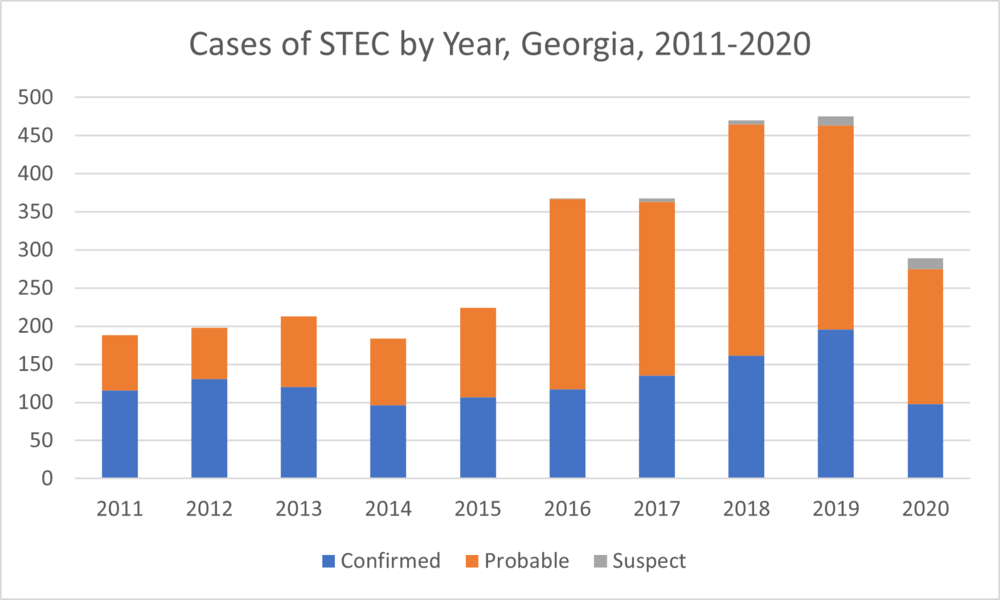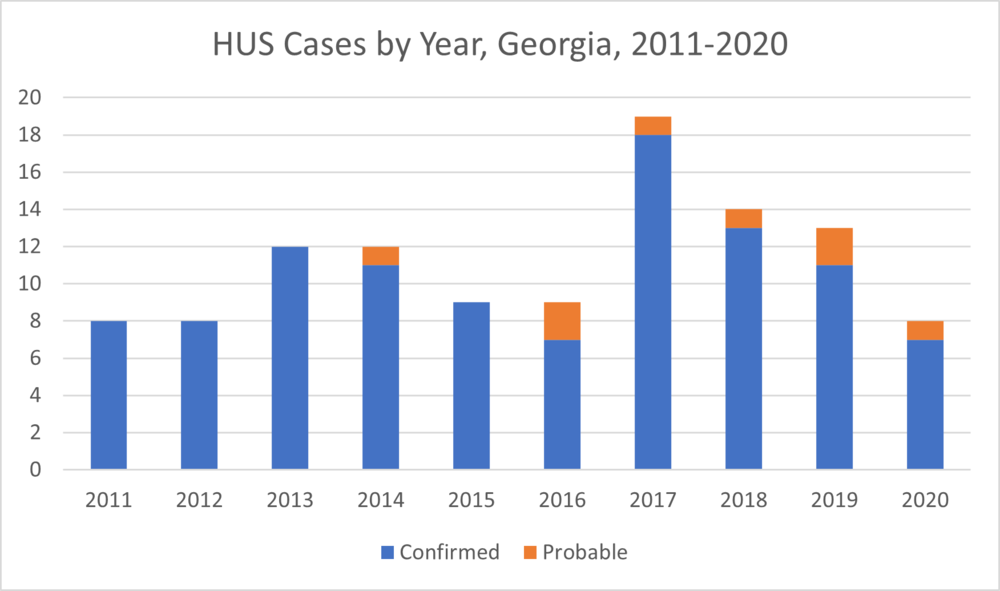
Shiga-toxin producing E. coli (includes E. coli O157)
Escherichia coli (E. coli) bacteria normally live in the intestines of people and animals. Most E. coli are harmless and actually are an important part of a healthy human intestinal tract. However, some E. coli are pathogenic, meaning they can cause illness, either diarrhea or illness outside of the intestinal tract. The types of E. coli that can cause diarrhea can be transmitted through contaminated water or food, or through contact with animals or persons. Shiga toxin-producing E. coli (STEC) is the one most commonly heard about in the news in association with foodborne outbreaks.
STEC Basics
The most commonly identified Shiga toxin-producing E. coli (STEC) is E. coli O157:H7. In addition to E. coli O157, many other kinds (serogroups) of STEC cause disease. Other E. coli serogroups in the STEC group are sometimes called “non-O157 STECs.” Compared with STEC O157 infections, identification of non-O157 STEC infections is more complex. First, clinical laboratories must test stool samples for the presence of Shiga toxins. Then, the positive samples must be sent to public health laboratories to look for non-O157 STEC. Clinical laboratories typically cannot identify non-O157 STEC. Some types of STEC frequently cause severe disease, including bloody diarrhea and hemolytic uremic syndrome (HUS), which is a type of kidney failure.
Hemolytic Uremic Syndrome (HUS)
HUS is a rare but serious disease that affects the kidneys and blood clotting system. HUS is caused by a powerful toxin produced by certain strains of bacteria, usually E. coli O157. It is a complex, potentially deadly condition that is the leading cause of acute kidney failure in infants and young children. Characteristically, HUS is marked by the destruction of red blood cells, damage to the lining of blood vessel walls, and kidney failure (in severe cases). Transfusions of blood or blood clotting factors (platelets) and dialysis are often needed in severe cases. Fortunately, most people with HUS recover completely and kidney function returns to normal. However, a prolonged hospital stay is often required.
STEC Information for Healthcare Professionals
Diagnosis and Treatment
STEC can be detected in stool by culture or culture-independent diagnostic test methods. Antibiotics are not recommended for patients with suspected STEC infections until complete diagnostic testing can be performed and STEC infection is ruled out. Some studies have shown that administering antibiotics to patients with STEC infections might increase their risk of developing HUS, and a benefit of treatment has not been clearly demonstrated.
Healthcare professionals with STEC
STEC can be transmitted in patient care settings. It is common for infected individuals to continue to shed the bacteria and remain infectious to others after symptoms resolve. Healthcare workers should not return to work until cleared by public health with follow up stool cultures. Contact your local health department for more information.
STEC Information for Schools and Childcare
General information for schools and childcare settings
STEC is a notifiable disease in Georgia, and it is included on the Common Infectious Illnesses poster. Because it is not possible to tell between diarrhea caused by STEC and diarrhea caused by other illnesses without stool testing, it is important to maintain policies that exclude ill staff and students. In general, people should be fever, diarrhea, and vomiting-free without the aid of medication for at least 24 hours before returning to childcare settings. If STEC is diagnosed or suspected, contact the local health department for exclusion requirements, which may include follow-up testing. If multiple students or staff have symptoms of STEC (or other communicable diseases), contact the local health department immediately to report the illnesses and for recommendations.
Children under five with STEC
STEC can spread in childcare settings. It is common for infected individuals to continue to shed the bacteria and remain infectious to others after symptoms resolve. Children under five should not return to childcare settings until cleared by public health with follow up stool cultures. Contact your local health department for more information.
Childcare workers with STEC
STEC can spread in childcare settings. It is common for infected individuals to continue to shed the bacteria and remain infectious to others after symptoms resolve. Childcare workers should not return to childcare settings until cleared by public health with follow up stool cultures. Contact your local health department for more information.
STEC Information for Food Handlers
STEC is easily transmitted in food service settings. It is common for infected individuals to continue to shed the bacteria and remain infectious to others after symptoms resolve. The Georgia Food Code has specific rules and regulations requiring exclusion of food handlers with STEC. Food handlers must not return to work until cleared by public health with follow up stool cultures. Contact your local health department for more information.
STEC/HUS Surveillance
STEC and HUS are reportable in Georgia. All laboratory positive results are reportable to the Georgia Department of Public Health.
Since 2015, Georgia has seen an increase in the number of reported cases of STEC.

Confirmed: Isolation of STEC from a clinical specimen
Probable: Detection of STEC using a culture-independent diagnostic method (i.e. PCR) from a clinical specimen
Suspect: Detection of STEC using a culture-independent diagnostic method (i.e. PCR) from a clinical specimen with no known clinical compatibility.

Confirmed: An acute illness diagnosed as HUS or TTP that both meets the laboratory criteria and began within 3 weeks after onset of an episode of acute or bloody diarrhea.
Probable: An acute illness diagnosed as HUS or TTP that meets the laboratory criteria in a patient who does not have a clear history of acute or bloody diarrhea in preceding 3 weeks OR microangiopathic changes are not confirmed.
Other Resources
CDC STEC Website: https://www.cdc.gov/ecoli/